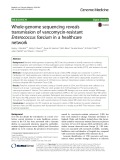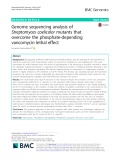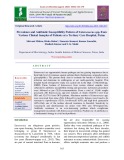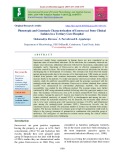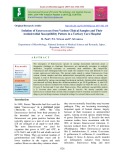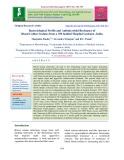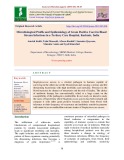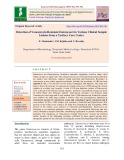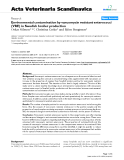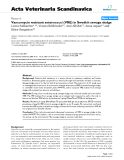
Vancomycin resistant Enterococci
-
Bacterial whole-genome sequencing (WGS) has the potential to identify reservoirs of multidrugresistant organisms and transmission of these pathogens across healthcare networks. We used WGS to define transmission of vancomycin-resistant enterococci (VRE) within a long-term care facility (LTCF), and between this and an acute hospital in the United Kingdom (UK).
 9p
9p  vioraclene
vioraclene
 31-03-2024
31-03-2024
 2
2
 2
2
 Download
Download
-
Vancomycin-resistant enterococci (VRE) are successful nosocomial pathogens able to cause hospital outbreaks. In the Netherlands, core-genome MLST (cgMLST) based on short-read sequencing is often used for molecular typing. Long-read sequencing is more rapid and provides useful information about the genome’s structural composition but lacks the precision required for SNP-based typing and cgMLST.
 9p
9p  vilarryellison
vilarryellison
 29-10-2021
29-10-2021
 13
13
 1
1
 Download
Download
-
Glycopeptide antibiotics inhibit bacterial cell-wall synthesis, and are important for the treatment of infections caused by multi drug-resistant strains of enterococci, streptococci and staphylococci. The main mechanism by which bacteria resist the action of glycopeptides is by producing a modified cell-wall in which the dipeptide D-Alanine-D-Alanine is substituted by D-Alanine-D-Lactate or D-Alanine-D-Serine. Recently, it has been shown that inorganic phosphate (Pi) induces hypersensitivity to vancomycin in Streptomyces coelicolor (which is highly resistant to the antibiotic in low-Pi media).
 16p
16p  vibeauty
vibeauty
 23-10-2021
23-10-2021
 13
13
 1
1
 Download
Download
-
The present study aims to estimate the burden of Enterococcal infection and determine its antibiogram at our multi-speciality hospital. This hospital based retrospective study was carried out in the Dept. of Microbiology, IGIMS, Patna. Isolates of Enterococci from various clinical samples were subjected to antibiotic susceptibility testing and speciation.
 8p
8p  trinhthamhodang11
trinhthamhodang11
 27-04-2021
27-04-2021
 10
10
 1
1
 Download
Download
-
Enterococci mainly being commensals in human faeces are now considered as an important cause of nosocomial infections. Of the infections, the commonly observed are urinary tract infections, abdominal infections followed by bacteremia, endocarditis and meningitis rarely. Speciation of Enterococcus aids in effective management of the infections caused by them. The initial treatment for enterococcal infections has become challenging due to development of resistance. The resistance has been observed mainly against aminoglycosides due to the presence of bi-functional gene.
 14p
14p  chauchaungayxua8
chauchaungayxua8
 03-10-2020
03-10-2020
 15
15
 2
2
 Download
Download
-
Enterococci have emerged as an increasingly important cause of nosocomial infections in patients with cancer. The emergence of vancomycin-resistant enterococci (VRE) is a cause of concern, as once established, it is very difficult to control. A study on the characterization and antimicrobial susceptibility pattern of clinical isolates of enterococci from patients with cancer was carried out in the Division of Microbiology, Regional Cancer Centre, Thiruvananthapuram for a period of three months.
 8p
8p  nguaconbaynhay6
nguaconbaynhay6
 24-06-2020
24-06-2020
 11
11
 1
1
 Download
Download
-
The emergence of Enterococcus species in causing nosocomial infections poses a therapeutic challenge to clinicians. Enterococci are intrinsically resistance to multiple antibiotics. Acquired resistance to commonly used antibiotics like Ampicillin, Vancomycin and Aminoglycosides have made the situation worse and difficult to treat serious enterococcal infections. The present study aimed to isolate Enterococcus from various clinical samples and their antimicrobial susceptibility pattern in a tertiary care hospital.
 7p
7p  nguaconbaynhay6
nguaconbaynhay6
 24-06-2020
24-06-2020
 18
18
 0
0
 Download
Download
-
Blood stream infections can lead to life threatening sepsis and require immediate antimicrobial treatment. Blood culture is an essential tool for the investigation of clinically suspected bacteremia or septicemia. A timely detection of organism type and antibiotic susceptibility testing is critical for the effective treatment of the patient. Illness associated with blood stream infection ranges from self-limiting infections to life-threatening sepsis that require rapid and aggressive antimicrobial treatment.
 10p
10p  nguaconbaynhay6
nguaconbaynhay6
 23-06-2020
23-06-2020
 24
24
 1
1
 Download
Download
-
Staphylococcus aureus is a virulent pathogen in humans capable of surviving in the otherwise sterile bloodstream and causing a serious and life threatening bacteremia with high morbidity and mortality. Presence in the blood increases its chances of metastasis and the risk of fatality. The choice of antibiotic therapy has conventionally relied to a large extent on the susceptibility of the pathogen to methicillin.
 10p
10p  quenchua2
quenchua2
 16-12-2019
16-12-2019
 17
17
 1
1
 Download
Download
-
Enterococci are Gram-positive, facultative anaerobic organisms, ovoid in shape, short chains, in pairs or single cells. The common enterococci-associated nosocomial infections are urinary tract infections, surgical wound infections and bacteremia. Resistance to vancomycin is now widely reported worldwide. In India, the prevalence of VRE has been reported as’ 8%, 5.5% and 23% in New Delhi, Chandigarh, and Mumbai. This study was done to detect the presence of vancomycin resistant enterococci (VRE) among the various samples in a tertiary care hospital.
 7p
7p  cothumenhmong1
cothumenhmong1
 08-12-2019
08-12-2019
 25
25
 0
0
 Download
Download
-
Tuyển tập các báo cáo nghiên cứu về bệnh học thý y được đăng trên tạp chí Acta Veterinaria Scandinavica cung cấp cho các bạn kiến thức về bệnh thú y đề tài: Environmental contamination by vancomycin resistant enterococci (VRE) in Swedish broiler production...
 6p
6p  coxanh_1
coxanh_1
 22-10-2011
22-10-2011
 52
52
 3
3
 Download
Download
-
Tuyển tập các báo cáo nghiên cứu về bệnh học thý y được đăng trên tạp chí Acta Veterinaria Scandinavica cung cấp cho các bạn kiến thức về bệnh thú y đề tài: Vancomycin resistant enterococci (VRE) in Swedish sewage sludge...
 9p
9p  coxanh_1
coxanh_1
 22-10-2011
22-10-2011
 43
43
 5
5
 Download
Download
-
Enterococci may be resistant to penicillins via two distinct mechanisms. The first is β-lactamase production (mediating resistance to penicillin and ampicillin), which has been reported for E. faecalis isolates from several locations in the United States and other countries. Because the amount of β-lactamase produced may be insufficient for detection by routine antibiotic susceptibility testing, isolates from serious infections should be screened specifically for βlactamase production with a chromogenic cephalosporin or another method.
 5p
5p  colgate_colgate
colgate_colgate
 21-12-2010
21-12-2010
 76
76
 4
4
 Download
Download
-
Vancomycin Clinically important resistance to vancomycin was first described among enterococci in France in 1988. Vancomycin-resistant enterococci (VRE) have subsequently become disseminated worldwide. The genes encoding resistance are carried on plasmids that can transfer themselves from cell to cell and on transposons that can jump from plasmids to chromosomes. Resistance is mediated by enzymes that substitute D-lactate for D-alanine on the peptidoglycan stem peptide so that there is no longer an appropriate target for vancomycin binding.
 5p
5p  colgate_colgate
colgate_colgate
 21-12-2010
21-12-2010
 64
64
 2
2
 Download
Download
CHỦ ĐỀ BẠN MUỐN TÌM








